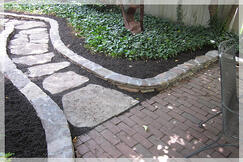 If your lawn is looking lackluster, landscape edging offers a fast and inexpensive solution. Edging can reinvent a cookie-cutter lawn, with an attractive, curved border. It can complement your home’s exterior and outdoor accessories. But it’s also functional, as well.
If your lawn is looking lackluster, landscape edging offers a fast and inexpensive solution. Edging can reinvent a cookie-cutter lawn, with an attractive, curved border. It can complement your home’s exterior and outdoor accessories. But it’s also functional, as well.
Landscape edging lets you redefine your yard’s borders and beds. It will keep mulch or pebbles out of the grass, while giving your yard a clean, manicured look. You can use a wide variety of materials for your landscape edging, depending on your outdoor style and your budget.
Landscape edging options include:
Wood Edging
This is one of the most popular options simply because of the cost. Wood edging is also a timeless option, and has the ability to give your landscape a more rustic feel. Wood edging products include tough varieties like redwood, cypress, and cedar. If these types of wood are not available, you could always take a look at pressure-treated wood. All of these types of wood will stand up well to rotting.
Plastic Edging
In most cases, plastic edging is the most durable edging option. It’s pliable and unlikely to crack or break. Plastic is also a very affordable option and it’s incredibly lightweight. However, plastic isn’t typically recommended for a sophisticated look. Homeowners with upscale housing fixtures often find that plastic detracts from their overall landscape effect.
Masonry Edging
Despite its higher price point, masonry edging is popular among today’s homeowners. Landscapes edged in masonry often include stone, brick, or concrete. The edging might consist of flat pavers or low retaining walls. Many people prefer stone and brick for their lasting qualities and traditional appearance. Products are available in various shapes, styles, and colors.
Steel Edging
This is one of the most expensive landscape edging materials available to you. But it’s also one of the sturdiest, as well. Steel or metal edging is not a good idea for people who live in fluctuating climates (e.g. the Northeast) because frost and heat tend to make the material heave. When steel edging is heaved or dislodged, it can be quite dangerous to have it in your yard.
Before you spend time and money installing your own landscape edging, you may wish to get a quote from a professional. A knowledgeable landscaper can review product options with you, and prepare the ground for a more lasting result. Whatever type of edging you select, you’ll love the resulting look!

 781-646-5555
781-646-5555